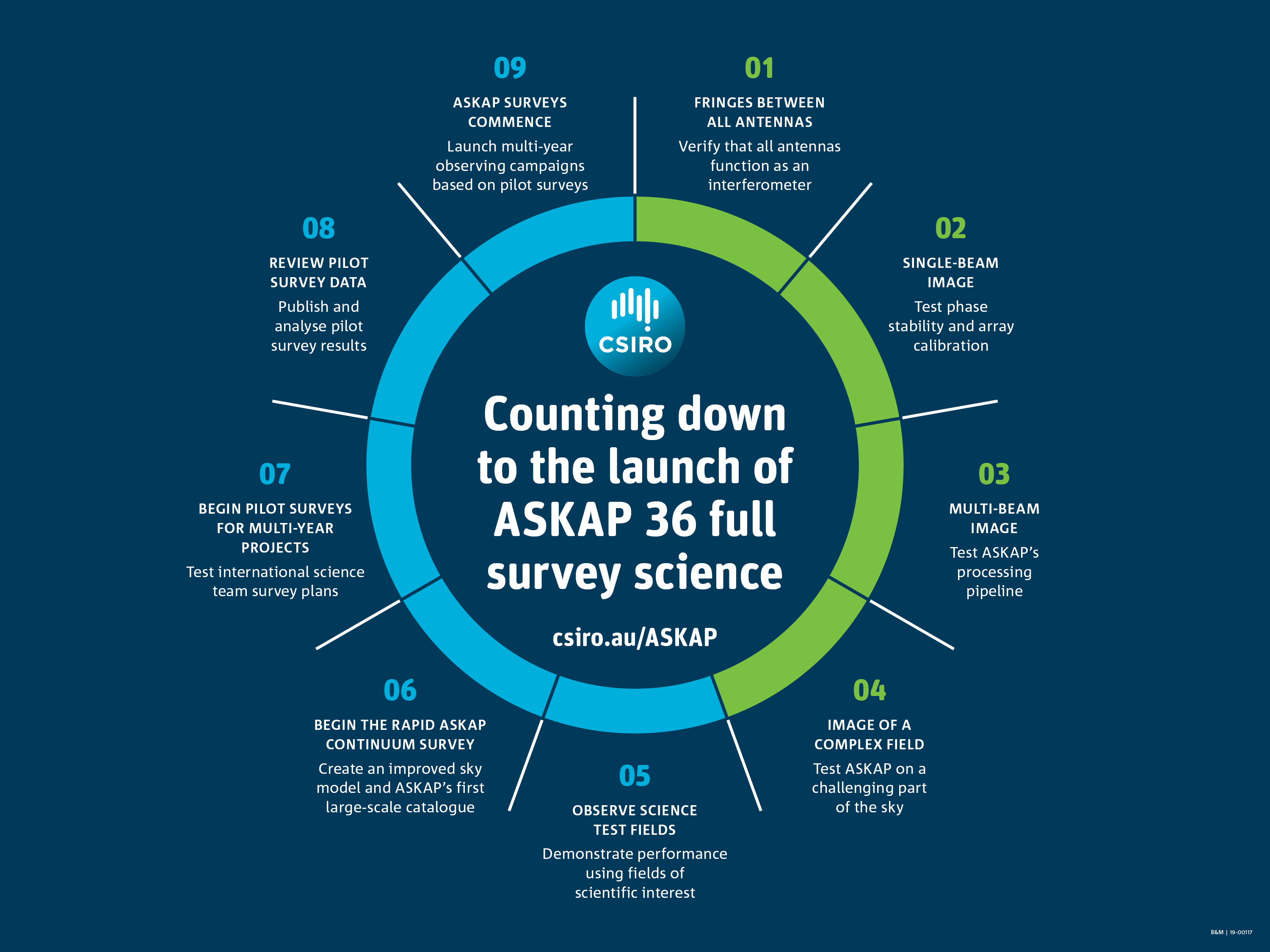Counting down to the launch of ASKAP 36 full survey science
Stage 4
Image of a complex field
 The countdown to ASKAP-36 full survey science is a campaign designed to share the telescope's final commissioning milestones with the astro-community and our partners.
The countdown to ASKAP-36 full survey science is a campaign designed to share the telescope's final commissioning milestones with the astro-community and our partners.
The process of bringing to life this complex science instrument, with its innovative engineering design, super-computing technology and wide-field survey capability doesn't come with a play-book and doesn't provide a single moment of victory, but rather a series of steps towards full capability.
CSIRO's ASKAP Commissioning Team is working through these final nine milestones and each one presents a higher level of complexity than the last.
Today's reveal is a great example of that increasing complexity. The ASKAP WALLABY (Widefield ASKAP L-band Legacy All-sky Blind surveY) Team processed 50TB of data, taken in just 10 hours on ASKAP.
One of the team leaders, CSIRO's Dr Karen Lee-Waddell processed this massive volume of data using our ASKAPSOFT processing pipeline and produced this great 3D image below.
Over to WALLABY!
To show ASKAP’s ability to image a complex field in three dimensions, we took spectral line observations of a region in the Eridanus constellation. This target field is the intervening area between two clusters of galaxies that are currently merging together. With the new ASKAP observations, we can better probe numerous galaxies in different stages of evolution, for a more thorough understanding of this merging process and its effects on the entire system.
The image below is a “cube” with one spectral and two spatial dimensions. This image cube was produced from about 10 hours of ASKAP observations, processed using ASKAPsoft, and shows only a small portion of ASKAP’s full field of view and spectral range. Each darker “blob” is a galaxy, detected using the 21-cm line emission of neutral hydrogen gas. There are seven neighbouring galaxies in this portion of space, one of which does not appear to have a stellar counterpart.
Neutral hydrogen gas
Neutral hydrogen resides in cold (T < 10000 K), diffuse clouds and is extremely important to our understanding of galaxies since it provides the raw material from which new stars can form. Hydrogen gas emits radio waves at a characteristic frequency (1.420 GHz) determined by the structure of a hydrogen atom. This so-called “spectral line” emission is like a clear musical note compared to the background noise of hundreds of voices all speaking at the same time.
The hydrogen gas that we observe is moving with respect to the Earth – both because the galaxy it lives in rotates, and because all galaxies tend to move away from each other as the universe expands. Spectral line emission is particularly interesting because we can detect when it is Doppler shifted – the same effect as a siren changing tone on a moving vehicle when it passes by a stationary observer. Astronomers can measure radial velocities using this effect and infer distances to the detected galaxies as well as glean information about the motion of the gas within each system. The third, shorter axis of the image cube is the translation of the observed velocity information provided by spectral line data, giving a 3D view of each galaxy and their relationship to each other.

The most noticeable galaxy in this group is NGC 1371, which has a ring-like distribution of hydrogen gas. The elongation of the galaxies in the third dimension indicates rotational motion as a portion of the gas is moving towards us, while another portion is moving away.
Neutral hydrogen is considered to be “optically thin” in galaxies meaning that depending on the brightness of the detections, we know how many atoms of hydrogen are contained within each system. Therefore, we can also compute the gas mass of these galaxies. Putting all this information together helps us understand not only the individual galaxies, but the environment in which they live.
Background on WALLABY
WALLABY (Widefield ASKAP L-band Legacy All-sky Blind surveY, https://wallaby-survey.org) is one of eight survey science projects being conducted with ASKAP. This survey will detect and image the neutral hydrogen gas distribution in and around hundreds of thousands of galaxies across 75% of the entire sky. WALLABY will enable astronomers to gain a much-improved understanding of the processes involved in galaxy formation and evolution.
